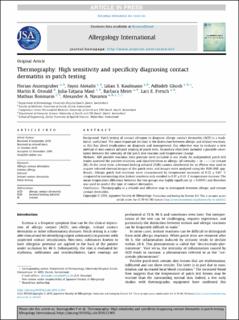Please use this identifier to cite or link to this item:
https://doi.org/10.21256/zhaw-3414Full metadata record
| DC Field | Value | Language |
|---|---|---|
| dc.contributor.author | Anzengruber, Florian | - |
| dc.contributor.author | Alotaibi, Fayez | - |
| dc.contributor.author | Kaufmann, Lilian S. | - |
| dc.contributor.author | Ghosh, Adhideb | - |
| dc.contributor.author | Oswald, Martin R. | - |
| dc.contributor.author | Maul, Julia-Tatjana | - |
| dc.contributor.author | Meier Käppeli, Barbara Katharina | - |
| dc.contributor.author | French, Lars E. | - |
| dc.contributor.author | Bonmarin, Mathias | - |
| dc.contributor.author | Navarini, Alexander A. | - |
| dc.date.accessioned | 2019-01-16T15:14:13Z | - |
| dc.date.available | 2019-01-16T15:14:13Z | - |
| dc.date.issued | 2018 | - |
| dc.identifier.issn | 1323-8930 | de_CH |
| dc.identifier.issn | 1440-1592 | de_CH |
| dc.identifier.uri | https://digitalcollection.zhaw.ch/handle/11475/14450 | - |
| dc.description | In Press | de_CH |
| dc.description.abstract | Background: Patch testing of contact allergens to diagnose allergic contact dermatitis (ACD) is a traditional, useful tool. The most important decision is the distinction between allergic and irritant reactions, as this has direct implications on diagnosis and management. Our objective was to evaluate a new method of non-contact infrared reading of patch tests. Secondary objectives included a possible correlation between the intensity of the patch test reaction and temperature change. Methods: 420 positive reactions from patients were included in our study. An independent patch test reader assessed the positive reactions and classified them as allergic (of intensity + to +++) or irritant (IR). At the same time, a forward-looking infrared (FLIR) camera attachment for an iPhone was used to acquire infrared thermal images of the patch tests, and images were analyzed using the FLIR ONE app. Results: Allergic patch test reactions were characterized by temperature increases of 0.72 ± 0.67°C compared to surrounding skin. Irritant reactions only resulted in 0.17 ± 0.31 °C temperature increase. The mean temperature difference between the two groups was highly significant (p < 0.0001) and therefore was used to predict the type of contact dermatitis. Conclusions: Thermography is a reliable and effective way to distinguish between allergic and irritant contact dermatitis. | de_CH |
| dc.language.iso | en | de_CH |
| dc.publisher | Japanese Society of Allergology | de_CH |
| dc.relation.ispartof | Allergology International | de_CH |
| dc.rights | http://creativecommons.org/licenses/by-nc-nd/4.0/ | de_CH |
| dc.subject | Allergic contact dermatitis | de_CH |
| dc.subject | Contact allergy | de_CH |
| dc.subject | Infrared | de_CH |
| dc.subject | Irritant contact dermatitis | de_CH |
| dc.subject | Patch testing | de_CH |
| dc.subject.ddc | 616: Innere Medizin und Krankheiten | de_CH |
| dc.title | Thermography : high sensitivity and specificity diagnosing contact dermatitis in patch testing | de_CH |
| dc.type | Beitrag in wissenschaftlicher Zeitschrift | de_CH |
| dcterms.type | Text | de_CH |
| zhaw.departement | School of Engineering | de_CH |
| zhaw.organisationalunit | Institute of Computational Physics (ICP) | de_CH |
| dc.identifier.doi | 10.21256/zhaw-3414 | - |
| dc.identifier.doi | 10.1016/j.alit.2018.12.001 | de_CH |
| dc.identifier.pmid | 30598404 | de_CH |
| zhaw.funding.eu | No | de_CH |
| zhaw.issue | 2 | de_CH |
| zhaw.originated.zhaw | Yes | de_CH |
| zhaw.publication.status | publishedVersion | de_CH |
| zhaw.volume | 68 | de_CH |
| zhaw.publication.review | Peer review (Publikation) | de_CH |
| zhaw.webfeed | Sensors and Measuring Systems | de_CH |
| Appears in collections: | Publikationen School of Engineering | |
Files in This Item:
| File | Description | Size | Format | |
|---|---|---|---|---|
| 1-s2.0-S1323893018301631-main.pdf | 1.26 MB | Adobe PDF |  View/Open |
Show simple item record
Anzengruber, F., Alotaibi, F., Kaufmann, L. S., Ghosh, A., Oswald, M. R., Maul, J.-T., Meier Käppeli, B. K., French, L. E., Bonmarin, M., & Navarini, A. A. (2018). Thermography : high sensitivity and specificity diagnosing contact dermatitis in patch testing. Allergology International, 68(2). https://doi.org/10.21256/zhaw-3414
Anzengruber, F. et al. (2018) ‘Thermography : high sensitivity and specificity diagnosing contact dermatitis in patch testing’, Allergology International, 68(2). Available at: https://doi.org/10.21256/zhaw-3414.
F. Anzengruber et al., “Thermography : high sensitivity and specificity diagnosing contact dermatitis in patch testing,” Allergology International, vol. 68, no. 2, 2018, doi: 10.21256/zhaw-3414.
ANZENGRUBER, Florian, Fayez ALOTAIBI, Lilian S. KAUFMANN, Adhideb GHOSH, Martin R. OSWALD, Julia-Tatjana MAUL, Barbara Katharina MEIER KÄPPELI, Lars E. FRENCH, Mathias BONMARIN und Alexander A. NAVARINI, 2018. Thermography : high sensitivity and specificity diagnosing contact dermatitis in patch testing. Allergology International. 2018. Bd. 68, Nr. 2. DOI 10.21256/zhaw-3414
Anzengruber, Florian, Fayez Alotaibi, Lilian S. Kaufmann, Adhideb Ghosh, Martin R. Oswald, Julia-Tatjana Maul, Barbara Katharina Meier Käppeli, Lars E. French, Mathias Bonmarin, and Alexander A. Navarini. 2018. “Thermography : High Sensitivity and Specificity Diagnosing Contact Dermatitis in Patch Testing.” Allergology International 68 (2). https://doi.org/10.21256/zhaw-3414.
Anzengruber, Florian, et al. “Thermography : High Sensitivity and Specificity Diagnosing Contact Dermatitis in Patch Testing.” Allergology International, vol. 68, no. 2, 2018, https://doi.org/10.21256/zhaw-3414.
Items in DSpace are protected by copyright, with all rights reserved, unless otherwise indicated.